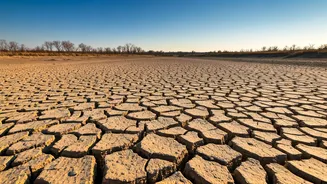Climate Risk Exposure
India's position as 9th in the Global Climate Risk Index underscores its substantial exposure to climate hazards. This ranking reflects the frequency and
severity of extreme weather events that have impacted the country over a prolonged period. The data reveals a complex interplay of factors contributing to this vulnerability, including geographic location, population density, and existing infrastructure. The country's extensive coastline, coupled with a large agrarian population, further elevates its susceptibility to climate-related disasters. Consequently, the analysis of these factors is crucial to understanding the scope of climate challenges faced by India. This understanding is vital for developing effective mitigation and adaptation strategies, ensuring resilience in the face of future climate impacts. These efforts include improved disaster preparedness, climate-resilient infrastructure development, and policy interventions. The government must focus on enhancing the country's capacity to anticipate, respond to, and recover from climate-related events effectively. The ultimate aim is to reduce the human and economic costs associated with these hazards.
Decades of Devastation
Over the course of three decades, India has borne the brunt of numerous climate-related disasters, resulting in significant loss of life. These include heatwaves, floods, droughts, and cyclones, all of which have taken a toll on human lives. According to the index, approximately 80,000 lives have been lost due to these events. The sheer scale of this loss is a sobering reminder of the devastating impact of climate change. Each disaster not only claims lives but also inflicts deep trauma on communities. Beyond human loss, these disasters have created widespread displacement, disrupted livelihoods, and strained social support systems. The long-term implications are far-reaching, encompassing physical and mental health challenges. Addressing the challenges, therefore, requires a comprehensive approach, including early warning systems, disaster preparedness initiatives, and resilient healthcare infrastructure.
Economic Impact: Billions Lost
The economic cost associated with climate disasters in India over the past 30 years has been staggering, reaching an estimated $170 billion. This financial burden includes the direct costs of damage to infrastructure, property, and agricultural losses. The indirect costs, encompassing healthcare expenses, business disruptions, and decreased productivity, further compound this economic strain. The loss of infrastructure, such as roads, bridges, and buildings, can impede economic activities and hinder development. Agricultural losses are particularly critical, impacting the livelihoods of millions of farmers and affecting food security. These economic ramifications undermine progress and divert resources from other essential sectors. Consequently, mitigating climate-related economic risks is critical. Investing in climate-resilient infrastructure, promoting sustainable agricultural practices, and developing financial mechanisms to aid in disaster recovery are essential steps. Furthermore, adopting proactive measures, such as early warning systems and insurance programs, can reduce the long-term economic vulnerability.
Multi-Faceted Vulnerability
India's vulnerability to climate change is multi-faceted, stemming from its geographic features, socio-economic factors, and development patterns. The country's diverse climate zones and extensive coastline make it particularly susceptible to a range of hazards, including floods, droughts, and cyclones. Population density, particularly in coastal and low-lying areas, increases the risk of loss of life and property. Moreover, the reliance on climate-sensitive sectors like agriculture exposes a large portion of the population to climate-induced economic shocks. Existing infrastructure, often not designed to withstand extreme weather events, further intensifies vulnerabilities. The confluence of these factors requires a comprehensive approach to enhance resilience, including ecosystem-based adaptation strategies. It is essential to integrate climate risk assessments into development planning, strengthen disaster preparedness, and build climate-resilient infrastructure. This approach will create a sustainable, resilient India capable of withstanding the impacts of climate change.















